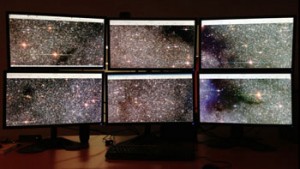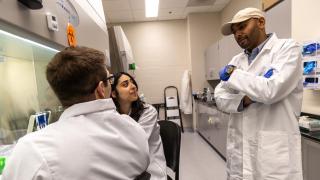

Raw images from DECam show a Milky Way dust cloud. Photo taken by Professor Will Clarkson in the CTIO control room.
But it wasn’t the light saber action that caught his attention—it was what came after the credits rolled: A documentary on the planets.
“I remember being captivated by that documentary,” said Clarkson, astronomy assistant professor. “From that point, you could say I was hooked.”
And now he views galaxies—the Milky Way galaxy and the ones far, far away—professionally.
For the third year, Clarkson is working on a national collaboration with colleagues from institutions including UCLA, Indiana University and the Harvard-Smithsonian Center for Astrophysics to make a map of the Milky Way to gain new insights into its formation history.
For this research, Clarkson is working with the Dark Energy Survey Camera (DECam) at the Cerro Tololo Inter-American Observatory (CTIO) in Chile. DECam is a large 570 Megapixel camera. Clarkson said, “It’s approximately the size of a Smart Car,” and “combines exquisite image quality with a huge field of view, enabling millions of stars to be captured in a single image.”
The one-of-a-kind camera, which is connected to the Victor Blanco 4m telescope at the CTIO observatory in Chile, captures images so large that a single image will record data from an area of the sky over four times the diameter of the full moon as seen from Earth. Led by Dr. R. Michael Rich of UCLA, a collaboration including Clarkson successfully proposed a multi-year program to turn DECam on the Milky Way Bulge.
“A galaxy bulge is a roughly peanut-shaped stellar population that extends some way out of the inner few thousand light-years of a typical spiral-galaxy disk,” Clarkson said. “Bulges are important actors in galaxy formation, and therefore allow us to test our understanding of the formation of structure through cosmic time.”
Clarkson said even though the Milky Way is the Earth’s home galaxy, there are still unknowns about it and its central bulge.
Some questions include: Which way is the bulge pointing? How many stellar populations are there? Did they form early and all at once or has there been extended star formation over a longer period of time?
Clarkson said it’s important to focus on the Milky Way so there can be a greater understanding of what’s happening close to home.
“We can measure the stars in our own galaxy, but there are still observational differences that pop up even when looking at the Milky Way,” he said. “Measuring stellar populations like these outside of the galaxy can be very, very difficult to do. Andromeda, the nearest spiral galaxy, is 2 million light years away, which means the same star in Andromeda would appear roughly one ten-thousandth as bright to us as it does in the Milky Way bulge. It’s important to understand what’s going on close to home so that we can correctly interpret observations at much greater distances.”
Clarkson said one example is the distribution of age in the Milky Way bulge. Some studies find roughly 20 percent of bulge stars formed within the last 5 billion years. But work by Clarkson and collaborators suggests that, at most, it’s 5 percent.
“That’s a pretty big difference, but it may yet be possible to reconcile the studies, probably by appealing to spatial variation. Someone has to go out there and capture as much of the bulge in as uniform a manner as possible,” he said. “And, with the Dark Energy Camera, that’s what we’re doing.
“I’m hopeful that the map will ultimately unlock some of the deepest mysteries about the formation of our own galaxy, and therefore help us understand galaxy formation throughout the universe.”
The project—the Blanco DECam Bulge Survey—has received continuous support through the National Optical Astronomy Observatory, which reviews project proposals and grants DECam time, and funding from the National Science Foundation. Clarkson also acknowledges support in this project from a Theodore Dunham, Jr. Grant from the Foundation Center and research support from UM-Dearborn College of Arts, Sciences, and Letters.
In addition to his own research, Clarkson is sharing the images taken with the DECam with his students and assisting them in their own research interests.
Physics major Lizzy Clyne said Clarkson first showed her a sample of the DECam images two years ago.
After seeing the images, she shared with Clarkson her interest in capturing images from UM-Dearborn’s observatory.
“With Professor Clarkson’s help, I did a long-term imaging project of the Type Ia supernova in Messier 82,” she said of the closest Ia supernova to earth in the past 42 years, which was first seen in January 2014. Clyne said Clarkson then took a group of students to the 2014 American Astronomical Society meeting in Boston, where she presented her Supernova research.
Clarkson said, from his experience, there’s no substitute for research—and that’s why he wants to get his students involved.
“It’s a chance to tackle a real astronomical problem. You use your own ingenuity and creativity and come up with a solution. Students wrestle with a problem that doesn’t have an answer in the back of a book,” he said. “Research shows our students just how much they can do with what they know. It gives them both experience and confidence for life after graduation.”




